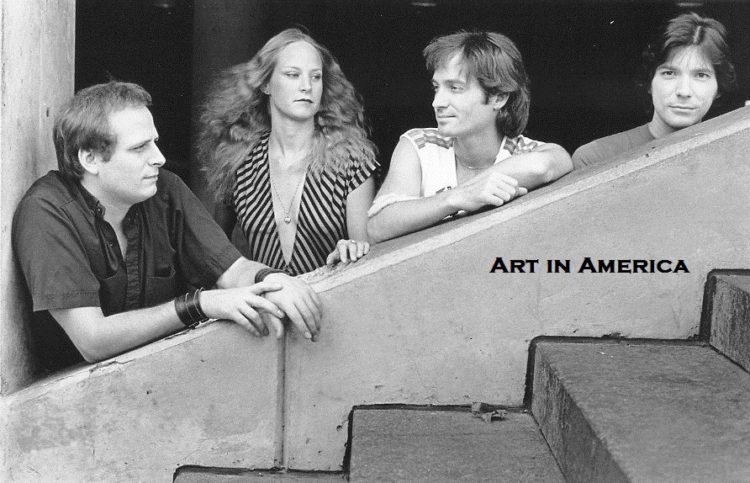
Fans of early 1980s eclectic American progressive rock band Art in America must have the proverbial patience of Job – as do the members of the band themselves. After an evocative, genre-bending and critically acclaimed debut album in 1983, the quartet basically dropped off the face of the Earth, at least in terms of their profile within the music industry.
Nary a peep was heard until a couple of years ago, when quiet rumblings of the possibility of a reunion and new music began to increase in frequency and volume, until earlier this year, not long after the dawning of the new decade, Art in America released their second album – the masterfully composed and produced Cloudborn on their own independent label, signalling to the music world, and especially to their long suffering fan base, that they were back.
Oh, but what a twisted and tangled tale It has been to get to this point, a story that is as much the epitome of the frustrating inertia of the monolithic music industry, as it is a hallmark of hope and perseverance.
Starting in Detroit, after spending their formative years in a suburb of Cleveland, what would become Art in America began in 1980, and after changing their name once Jim Kuha joined the Flynn siblings, Dan (drums), Shishonee (classical harp/vocals) and guitarist/lead vocalist Chris, the artful progressive rock stylings of the group soon had them opening for the likes of a very new U2, King Crimson and Roxy Music, and also garnered them a record deal with what is now Sony Music. Having a major label deal in the hot and heady 1980s also meant access to top line producers, with Art in America recording their self-titled debut album under the auspices of industry veteran Eddy Offord, best known for his work with Yes and Emerson, Lake and Palmer – true heavyweights of the prog world.
“It was a lot of fun working with Eddy. We recorded that album in Atlanta, Georgia, and our managers set us up in a house there. We recorded on his stage – it was actually an old movie house, but they also had plays there for many years, so there was an actual stage. We would record one run through so we could capture the drums and back then you re-recorded all the other instruments separately so they could be basically isolated and worked with in the mix. Eddy was great, and he used to run the harp though Marshalls and Ampeg amps with the reverb and got a great tone,” Chris said.
As for the band’s sound, having a harp in the band was not a gimmick, but a legitimate creative step to separate Art in America’s music and aesthetic from the rest of the music world. It added a unique dimension to the band’s sound, and an ethereal, old-world vibe to their stage shows.
“Our grandmother was a classical pianist, and our father was a musician as well. So, those elements are there in our music. But the British Invasion from the 1960s was very pivotal in my influences at least as a writer. And then again, there’s a lot of British folklore in our music, because our grandmother was British. So, there was the Beatles and The Moody Blues were a big band for me, as well as The Beach Boys and Spirit – we loved them. There are a lot of American influences. We grew up in Cleveland and Cleveland radio stations were bouncing back and forth between Motown and the British Invasion when we were kids, so we heard both,” Chris said, talking about the band’s influences and the foundation for much of his writing as the primary composer in the group.
“I write songs in a much shorter format than most prog artists do. I feel that once I have said what I need to say in a song, I don’t want to overstay my welcome. Basically, I will write any kind of song in any kind of format; I am just going to take the song where it basically wants to be taken and where it leads me. I’m following it in my own head and just experimenting and using trial and error and that kind of thing. At the end of the day, I would explain Art in America’s music as American Progressive Rock, although that’s pretty unoriginal.”

What sparked the process that ended with the release of this compelling, and in part, kind of a career retrospective for Art in America, was a fortuitous call from the agent representing well-respected, industry veteran David Hentschel, a producer of significant note, whose prodigious output includes working with the likes of Genesis, Elton John, Queen and the Beatles’ George Harrison. Chris Flynn explained that the band may have seemed dormant on the outside, but that the creative juices never stopped flowing behind the scenes.
“The band has continued to write for the last 30 or so years. The original [self titled] album was released in 1983, but we continued to write and continued to try to obtain a record deal for many, many years. Finally, we just decided we will keep writing anyways. So, we did, and we have a backlog of quite a bit of material – there are a good 75 songs in the can. Some of them are in varying degrees of completion, but most of them are pretty darn complete, they just needed a really good, modern production values,” he explained.
“About four years ago, we got contacted by David Hentschel’s agent and he said David wanted to know what Art in America is up to. He apparently always liked the band. So that started more discussions and we jumped at the opportunity because we’ve always loved Hentschel; we are big fans of Genesis, especially the albums that he produced [including A Trick of the Tail, Wind & Wuthering, ….And Then There Were Three, and Duke] and working with him excited the hell out of me. So, we talked with David and had a lot of conference calls and stuff like that. He had a clear cut method and a clear guy plan to get this thing done. He had picked a good 17 songs to record, but we started with six.
“I sent him the raw tracks of what I already had, because I had my computer set up for quite a while recording songs. I would fly tracks back and forth with Dan and Shishonee, having them add their parts. David did a lot of the premixing and basically what you call the ‘stem’ work. We also had a personal connection to Tony Levin [King Crimson, Peter Gabriel] and brought him in to do the bass playing on the six songs. And the rest is history. That’s how the process for this album started. Working with David was amazing, and we would like to do more recording with him.”
That takes care of the first six songs on Cloudborn: A Tale of the Unexpected, I am I, Someday, Drool, The New Swami and Someone Called My Name– the brand new-ish ones. So, what comprises the other six songs? They are part of the aforementioned 75 songs, composed throughout the 1980s, 1990s and up to the present day, that are stored in various stages of completion on Chris’s hard drive.
“We just picked the songs that we felt best fit the album, and that’s up to everybody’s own interpretation as to whether that was something that worked. We just picked the songs that we felt fit the Hentschel-produced tracks and that we really wanted on this record. It had nothing to do with whether they were really old or newer. And when I say ‘new’ I mean five to seven years old – that’s new to me. We’ve got songs on this record from as far back as 1984 and 1985,” he said, explaining that he produced four of the tracks: For Shelly, When We Were Young, Facelift and Don’t Look Down, while the band’s bassist Jim Kuha produced the last three songs on the album: No Wonder, and a three-movement epic that wraps up the album (which is technically two songs meshed together) – Goodbye My Love/Mind’s Eye/Peace of Mind.
“That last one was a song that was supposed to be on what was supposed to be our second album back in the day. And we actually recorded a second album, but it got shelved and we were never able to find a home for it. All those other songs are still available and accessible and will be coming out at some point, In fact I was working on one this morning. The response to Cloudborn and the process to put it together has already fired up the engines again for me,” said Chris.

“We would love David Hentschel to pop in and work on this new material, but that’s going to cost some more money. But we will see about that, because the days of being bankrolled by a record company are long over.”
Both Shishonee and Chris said they are pleased that Cloudborn has reawakened the band’s fan base and got them excited again.
“We really put an effort into making this album kind of a collector’s edition. We decided to make it a very high quality recording and also decided to add the special inserts and add some good photography as part of the package. And our drummer, our brother Dan, is an artist and it’s his artwork on the inside. We also put it out on our own label Edgewater Records, which is the street we grew up on in Lakewood, Ohio,” said Shishonee.
“It’s been very exciting to see the interest that has been generated by the new album and to know that people are still our there and enjoying this type of music.”
Chris added that many of the fans are saying it sounds like the band has picked up right where they left off.
“The truth is, we never left off. It’s just that we didn’t release anything. I have been putting stuff up on YouTube for years, and I have been posting music in various places on the internet since 2000, back in the old Myspace days and various other places that have since gone under. I have been putting stuff out there for anybody who was interested and even some of my home demos. I put them up there because I enjoy making them and I enjoy writing the songs and all of us enjoy taking part in the creation of it,” he said, adding that even the band is impressed how three sets of songs, all created and recorded in different eras, fit together sonically on one album. You’d be hard pressed to tell the different between ones created under Hentschel and ones from the archives.
“We’re pretty happy about that. I am glad that I can still sing and sound pretty much the same. I still have my voice and I am pretty happy about that. Anything I can sing, I can deliver on a recording, and as we proved on this record, we can make our own recordings. It doesn’t cost as much to have a home studio now, and we all still have our gear. Shishonee still has all her harps and Dan is playing the same set of drums that he had back in the 1980s, which they don’t even make any more.”
The big question on everyone’s lips is why it took so long to release a second album, regardless of whether it contained new music or not. According to Chris Flynn, much of it had to do with the vagaries of the music industry, including the pre-eminence and seeming omnipotence of corporate record labels to dictate so many aspects of the music creation and production process.
“It’s a lesson and a message for any band, even today. I would say to most young people to stand your ground and make sure you get a producer that really matches your vision and understands your music, who also possibly recorded and worked with bands that are like your band, or artists that are similar to you own music. What happened to us was we went with producers that were ill matched for us. They were working with groups like Gloria Estefan and Miami Sound Machine. When we went into the studio, they decided to replace our drummer with a drum machine. And these were people who were recommended by our own managers,” Chris said.
“They were the Albert Brothers [Ron and Howard] , who had big hits with John Cougar Mellencamp and Miami Sound Machine, and so they had us recording down at Criteria Studios in Miami. They had a lot of hits and these two guys were into our band, we thought. And then the minute we get down there, they are saying, ‘we’re going to record your band differently than you’ve done it before. It’s all going to be done to a click track and we’re going to build the drum sound first, and they you’re going to play along to a drum machine.’ Well, that’s not the kind of music that we are, and we never use a click when we’re recording. So, that was a mistake, and we ended up recording a really inferior product. That was pretty much the death knell of our band for many years.
“And then we bounced around and tried to get it happening again in terms of management. I had many conferences out here in California with [top industry A&R rep and record label executive] John David Kalodner, who is still in the business and he made a lot of promises of course, but none of them ever came to fruition. So here we are. But, as I said before I would tell anyone starting out in music to stand your ground and don’t expect to make a living out of music, just do it because you love it and eventually you will make some money out of it. Or you won’t – but either way you will still be making music.”
With the acclaim already stemming from the release of Cloudborn, Chris Flynn has not stopped working on the older material from the Art in America archives, and expects there to be ‘new’ music coming in the near future. He is also hopeful to get some sort of label backing for future releases too.
“I think we will start approaching people because the first album is now up for ownership. We have already terminated the contract on it, so we’re going to have a pretty nice little package to offer to a smaller label. We will be making some overtures to labels as soon as this next piece of music, the next album, is done. And it’s pretty much done now, but I am just working on three or four songs at the remixing stage to try and get them a little more up to snuff,” he said, adding that there is always the possibility of an onstage reunion too.
“We did some shows in the 1990s back in Los Angeles, but it was ‘pay per play’ days, which is still happening there at this time. So, we got tired of the situation of having to purchase our own tickets and then sell them, like a salesperson in the street. We declined to participate in that anymore. There hasn’t been as much interest since then as we would like, but we’re certainly open to playing live again.”
For more information, visit www.artinamericamusic.com.
- Jim Barber is a veteran award-winning journalist and author based in Napanee, ON, who has been writing about music and musicians for 30 years. Besides his journalistic endeavours, he now works as a communications and marketing specialist. Contact him at jimbarberwritingservices@gmail.com.
SHARE THIS POST:
